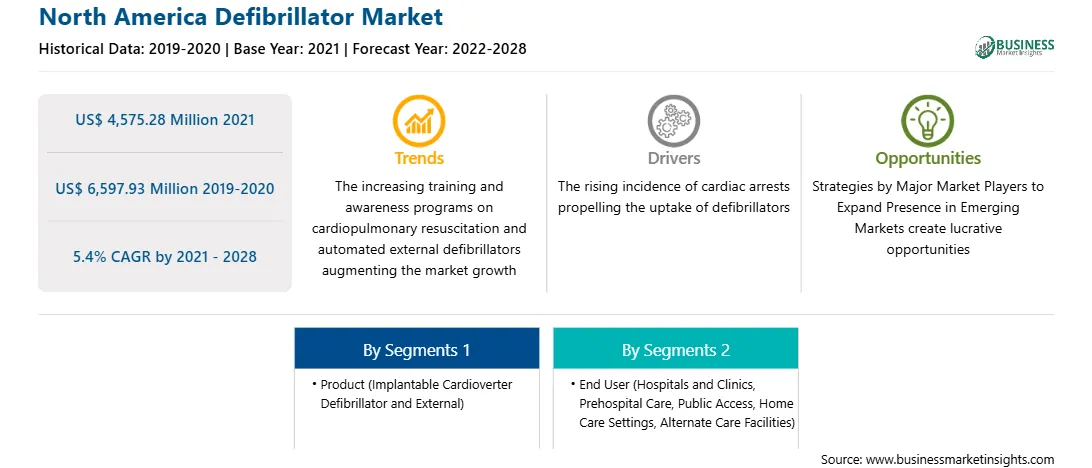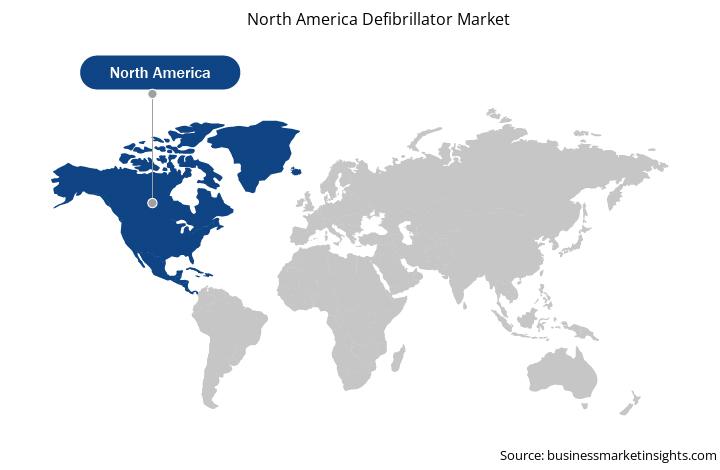Market Introduction
The North America Defibrillator market has been segmented into the US, Canada, and Mexico. The US held the largest share of the North America Defibrillator market in 2021. Increasing adoption of technological advancements and rising research and development activities are projected to accelerate the growth of the Defibrillator market. Moreover, the presence of large healthcare businesses and the growing usage of Defibrillator is propelling the market's expansion in this region. The US is projected to be the largest market for defibrillators, the market is attributed due to multiple factors such as increase in cardiovascular disease, rising awareness about the presence of innovative defibrillators, presence of leading pharmaceutical companies in this region and presence of well-developed healthcare infrastructure. Moreover, in terms of technology, the nation is well ahead of other developed and emerging countries. Advances in technology have resulted in the development of various novel defibrillators and technologies that are used for their applications. Coronary artery disease is one of the leading causes of morbidity and mortality in well-matured countries. According to the Center for Disease Control research, one in four deaths were due to coronary artery disease. Coronary artery disease cost more than US$100 billion a year in human productivity. In addition, the study released by the American Heart Association in 2018 reports that one in three deaths were caused by cardiovascular disease. Approximately 2,300 Americans die of cardiovascular disease each year and an average of one death is recorded every 38 seconds. Almost 92.1 million adults in the US suffer from some form of cardiovascular disease. The indirect and direct costs of overall cardiovascular disease and stroke are estimated to total more than US$ 329.7 billion, including both health and productivity losses. The population of people aged 65 and up is predicted to increase between 2012 and 2050. This growth needs a greater understanding of the impact of cardiovascular diseases in the older adults. Along with this, the rising prevalence of the cardiac conditions among the people also contribute to defibrillator market growth. As per the American Heart Association's "Heart Disease and Stroke Statistics 2019”, around 121.5 million adults in the US are living with cardiovascular disease, and every year 805,000 Americans suffer from a heart attack. Additionally, according to the CDC, about 795,000 people in the U.S. suffer from cerebrovascular stroke every year. Therefore, the cost of the treatments increases for the patients. The indirect and direct cost associated with the total cardiovascular diseases and stroke are anticipated to entire more than US$ 329.7 billion which includes both health expenditures and productivity loss. Additionally, across the country heart disease and stroke are the first and fifth leading cause of death. Hypertension is major risk factor for the heart disease, strokes and cardiac arrests and is expensive in terms of lives lost and health outcomes, however it is greatly treatable. According to the Centers for Disease Control and Prevention statistics, in 2018 approximately 75 million adults across US lived with high blood pressure. The prevalence is expected to rise in the coming future and therefore, it is anticipated that the incidences of the cardiovascular is likely to increase in future. Also, the US is among the highly advanced countries which have various technologies available for the medical devices, the country is also involved in the research and development of the medical technologies.
In North America, the US was severely impacted by the emergence of the COVID-19 pandemic. The country has had the highest number of COVID-19 patients with over 68 million reported cases and more than 856,000 deaths as per data given by the US Department of Health & Human Services and CDC as of January 19, 2022.The US is going through another surge in COVID-19 cases due to the omicron variant of SARS-CoV-2, which is expected to peak by January-end, 2022. Mexico is going through its biggest COVID-19 wave and has been registering a massive surge in COVID-19 cases. Similarly, Canada has gone through a recent wave of COVID-19 with the total number of cases rising to over ~2.84 million and 32,000 deaths, as of January 20th, 2022. As the hospital admissions and pressure on the healthcare infrastructure rose, the demand for defibrillators and other medical devices increased owing to their importance in in-hospital resuscitation and in-home settings with implantable cardioverter?defibrillator. Initial assessments showed fast, abnormal heart rates as a symptom experienced by many COVID-19 patients, and therefore, various recommendations and bulletins were issued by the CDC and the American College of Cardiology warning patients about the potential risk for cardiac patients and encouraging the use of automated external defibrillators along with various other precautions. As people with heart conditions were at the highest risk of contracting SARS-CoV-2, the demand for defibrillators in hospitals peaked, which were needed to treat cardiac arrests in critically ill patients. Studies conducted by various authorities showed a rise in the importance of defibrillators in hospitals and an increase in the usage of defibrillators in other settings. Organizations such as the World Health Organization (WHO), CDC, and the American College of Cardiology emphasized the presence of defibrillators in hospitals as an essential tool for combating the disease. The International Liaison Committee on Resuscitation or ILCOR also updated their guidelines through focused defibrillation training to avoid compromising the care of the patient experiencing tachyarrhythmia arrests, which also protected the caregiver from exposure to the virus. A 2020 study titled “Implantable Cardioverter?Defibrillator Shocks During COVID?19 Outbreak” by Adabag et.al., used the Medtronic Carelink database during 2019–2020 to determine the incidence of implantable defibrillator shock episodes among patients residing in New York, New Orleans, and Boston. The study found a significant increase in defibrillator shock episodes during the COVID-19 pandemic compared to 2019. Another study published in 2021 titled “The Role of the Automated Implantable Cardioverter Defibrillator (AICD) for Secondary Prevention in the COVID-19 Era,” presented a case of COVID-19 in a New York City Hospital who rapidly developed sudden cardiac arrest after presenting to the emergency room. The study concluded by emphasizing the use of automated implantable cardioverter defibrillator (AICD) with subclinical cardiac injury in COVID-19 patients post-recovery showing an upward trend. The study recommended the use of AICD as a secondary preventive measure to prevent recurrence of SCA and sudden cardiac deaths.
Various studies, rise in the number of COVID-19 cases, and emphasis laid down on the use of defibrillators as a preventive instrument in preventing cardiac arrests by various governmental and nongovernmental organizations showcased a positive impact on the defibrillator market with the application of defibrillators rising in hospitals and nonhospital.
Strategic insights for the North America Defibrillator provides data-driven analysis of the industry landscape, including current trends, key players, and regional nuances. These insights offer actionable recommendations, enabling readers to differentiate themselves from competitors by identifying untapped segments or developing unique value propositions. Leveraging data analytics, these insights help industry players anticipate the market shifts, whether investors, manufacturers, or other stakeholders. A future-oriented perspective is essential, helping stakeholders anticipate market shifts and position themselves for long-term success in this dynamic region. Ultimately, effective strategic insights empower readers to make informed decisions that drive profitability and achieve their business objectives within the market. The geographic scope of the North America Defibrillator refers to the specific areas in which a business operates and competes. Understanding local distinctions, such as diverse consumer preferences (e.g., demand for specific plug types or battery backup durations), varying economic conditions, and regulatory environments, is crucial for tailoring strategies to specific markets. Businesses can expand their reach by identifying underserved areas or adapting their offerings to meet local demands. A clear market focus allows for more effective resource allocation, targeted marketing campaigns, and better positioning against local competitors, ultimately driving growth in those targeted areas.North America Defibrillator Strategic Insights

North America Defibrillator Report Scope
Report Attribute
Details
Market size in 2021
US$ 4,575.28 Million
Market Size by 2028
US$ 6,597.93 Million
Global CAGR (2021 - 2028)
5.4%
Historical Data
2019-2020
Forecast period
2022-2028
Segments Covered
By Product
By End User
Regions and Countries Covered
North America
Market leaders and key company profiles
North America Defibrillator Regional Insights

Market Overview and Dynamics
The defibrillator market in North America is expected to grow from US$ 4,575.28 million in 2021 to US$ 6,597.93 million by 2028; it is estimated to grow at a CAGR of 5.4% from 2021 to 2028. Technological advancements; technological advancements and increased investments in defibrillators by private players are leading to significant future trends in the defibrillator market. In October 2020, Abbott Laboratories launched its new Gallant ICD and CRT-D that enable patient management and remote monitoring through smartphone connectivity and apps. Likewise, in June 2021, ZOLL improved its defibrillator management software, which was highly vulnerable to unrestricted file upload bugs, insecure password storage, and a privilege escalation issue. In September 2019, Shenzhen Mindray Bio-Medical Electronics Co., Ltd. launched the BeneHeart C Series of AEDs with smarter operations and faster shock delivery to achieve better resuscitation outcomes for sudden cardiac arrest (SCA). This is bolstering the growth of the defibrillator market.
Key Market Segments
Based on product, the market is segmented into implantable cardioverter defibrillator (ICD) and external. In 2020, the implantable cardioverter defibrillator segment held the largest share North America defibrillator market. The implantable cardioverter defibrillator is further sub-segmented into transvenous ICD and subcutaneous ICD. The transvenous ICD segment accounts for largest market share in the 2020. Similarly, the external segment is sub-segmented into manual, wearable, and fully automated external defibrillators. In 2020, the manual segment held the largest share of the market. Based on end user, the North America defibrillator market is segmented into hospitals and clinics, prehospital care, public access, home care settings, and alternate care facilities. The hospitals and clinics segment held the largest share of the market in 2020.
Major Sources and Companies Listed
A few major primary and secondary sources referred to for preparing this report on the defibrillator market in North America are company websites, annual reports, financial reports, national government documents, and statistical database, among others. Major companies listed in the report are Abbott; Biotronik, Inc; Boston Scientific Corporation; Koninklijke Philips N.V.; Medtronic; Nihon Kohden Corporation; Shenzhen Mindray Biomedical Electronics Co., Ltd; and ZOLL MEDICAL CORPORATION among others.
Reasons to buy report
NORTH AMERICA DEFIBRILLATOR MARKET SEGMENTATION
By Country
Company Profiles
The North America Defibrillator Market is valued at US$ 4,575.28 Million in 2021, it is projected to reach US$ 6,597.93 Million by 2028.
As per our report North America Defibrillator Market, the market size is valued at US$ 4,575.28 Million in 2021, projecting it to reach US$ 6,597.93 Million by 2028. This translates to a CAGR of approximately 5.4% during the forecast period.
The North America Defibrillator Market report typically cover these key segments-
The historic period, base year, and forecast period can vary slightly depending on the specific market research report. However, for the North America Defibrillator Market report:
The North America Defibrillator Market is populated by several key players, each contributing to its growth and innovation. Some of the major players include:
The North America Defibrillator Market report is valuable for diverse stakeholders, including:
Essentially, anyone involved in or considering involvement in the North America Defibrillator Market value chain can benefit from the information contained in a comprehensive market report.